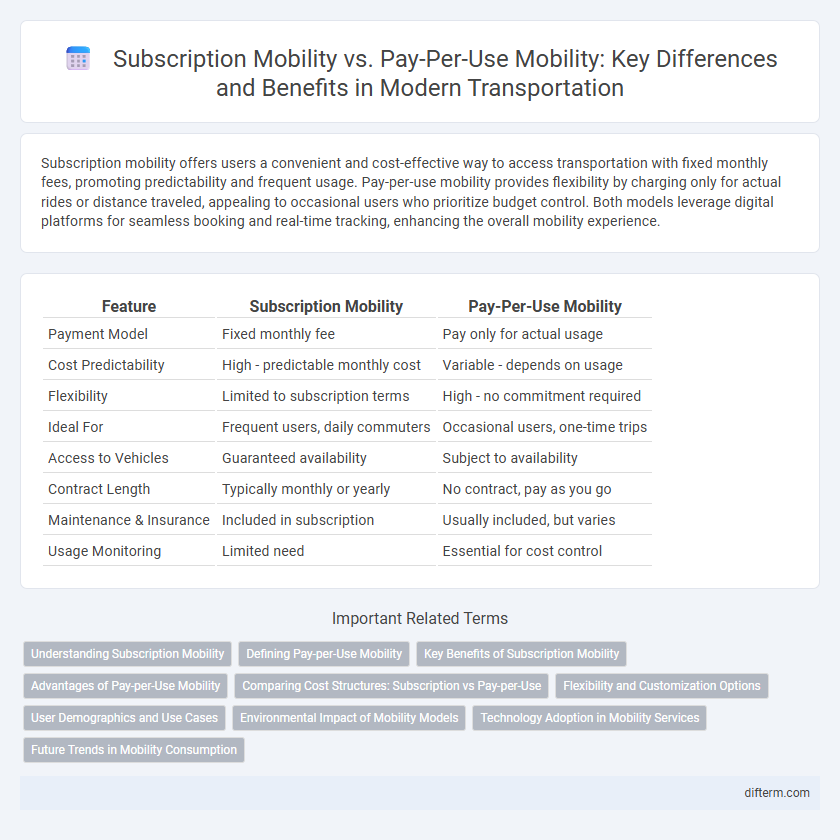Subscription mobility offers users a convenient and cost-effective way to access transportation with fixed monthly fees, promoting predictability and frequent usage. Pay-per-use mobility provides flexibility by charging only for actual rides or distance traveled, appealing to occasional users who prioritize budget control. Both models leverage digital platforms for seamless booking and real-time tracking, enhancing the overall mobility experience.
Table of Comparison
| Feature | Subscription Mobility | Pay-Per-Use Mobility |
|---|---|---|
| Payment Model | Fixed monthly fee | Pay only for actual usage |
| Cost Predictability | High - predictable monthly cost | Variable - depends on usage |
| Flexibility | Limited to subscription terms | High - no commitment required |
| Ideal For | Frequent users, daily commuters | Occasional users, one-time trips |
| Access to Vehicles | Guaranteed availability | Subject to availability |
| Contract Length | Typically monthly or yearly | No contract, pay as you go |
| Maintenance & Insurance | Included in subscription | Usually included, but varies |
| Usage Monitoring | Limited need | Essential for cost control |
Understanding Subscription Mobility
Subscription mobility provides users with unlimited access to various transportation options for a fixed monthly fee, simplifying budget management and enhancing travel convenience. This model supports seamless integration across public transit, bike-sharing, and car rentals, promoting sustainable urban mobility. Subscription plans are gaining popularity in smart cities by offering cost-effective, flexible, and eco-friendly alternatives to traditional car ownership.
Defining Pay-per-Use Mobility
Pay-per-use mobility allows users to access transportation services and pay only for the distance or time they actually use, offering flexibility and cost efficiency compared to fixed-rate subscription models. This model leverages real-time tracking and usage data to calculate fees precisely, making it ideal for occasional or unpredictable travel patterns. Pay-per-use mobility encourages resource optimization and reduces idle vehicle time, contributing to sustainable urban transportation solutions.
Key Benefits of Subscription Mobility
Subscription mobility offers predictable monthly costs, enhancing budget management for users by providing unlimited or capped access to various transportation modes. It encourages sustainable travel choices through integrated multimodal options, reducing dependence on personal vehicles and lowering carbon emissions. Subscribers benefit from seamless service access, priority support, and flexible plan adjustments tailored to their evolving mobility needs.
Advantages of Pay-per-Use Mobility
Pay-per-use mobility offers cost efficiency by allowing users to pay only for the distance or time they actually travel, eliminating fixed subscription fees. This flexible model encourages environmentally friendly travel choices through reduced vehicle ownership and decreased congestion. It also adapts to fluctuating demand and diverse travel patterns, providing personalized mobility solutions without long-term commitments.
Comparing Cost Structures: Subscription vs Pay-per-Use
Subscription mobility offers predictable monthly fees that cover unlimited usage, making budgeting simpler for frequent travelers. Pay-per-use mobility charges based on actual usage, often resulting in lower costs for infrequent users but potential spikes during high-demand periods. Companies must analyze travel frequency and usage patterns to select the most cost-effective mobility model.
Flexibility and Customization Options
Subscription mobility offers greater flexibility through fixed monthly plans, enabling users to access a variety of vehicles with consistent costs and customizable duration options. Pay-per-use mobility provides enhanced customization by allowing users to pay exclusively for the distance or time traveled, ideal for irregular or spontaneous trips. Both models cater to different mobility needs, with subscription plans favoring predictable usage and pay-per-use prioritizing cost-efficiency and on-demand access.
User Demographics and Use Cases
Subscription mobility appeals primarily to urban professionals and frequent commuters who demand predictable monthly costs and seamless access across multiple transport modes. Pay-per-use mobility attracts occasional users, tourists, and students seeking flexible, cost-efficient options without long-term commitments. Diverse use cases include daily commuting for subscriptions and spontaneous, short trips for pay-per-use services, highlighting distinct needs based on frequency and trip purpose.
Environmental Impact of Mobility Models
Subscription mobility models reduce environmental impact by encouraging longer vehicle use cycles and optimizing fleet management, which decreases resource consumption and emissions. Pay-per-use mobility promotes efficient, demand-based transportation that can lower overall vehicle kilometers traveled and reduce congestion, leading to decreased carbon footprints. Both models contribute to sustainable urban mobility by minimizing private car ownership and enabling shared access to low-emission vehicles.
Technology Adoption in Mobility Services
Subscription mobility offers users seamless access to diverse transportation options through integrated digital platforms, driving higher technology adoption in mobility services by simplifying usage and payment processes. Pay-per-use mobility relies on real-time data analytics and IoT connectivity to optimize vehicle availability and enhance user experience, promoting flexible and on-demand technology utilization. Both models leverage mobile applications, GPS tracking, and AI-driven algorithms to transform urban transportation and accelerate smart mobility technology integration.
Future Trends in Mobility Consumption
Subscription mobility offers predictable costs and seamless access to multiple transport modes, driving user loyalty and integrated service ecosystems. Pay-per-use mobility appeals to flexible, spontaneous travel needs, leveraging real-time data and dynamic pricing to optimize resource allocation. Future trends emphasize hybrid models combining subscription benefits with pay-per-use flexibility, powered by AI-driven personalization and sustainable urban mobility solutions.
Subscription mobility vs Pay-per-use mobility Infographic

 difterm.com
difterm.com